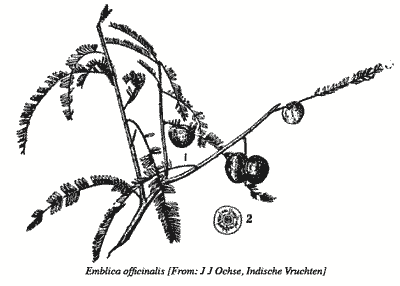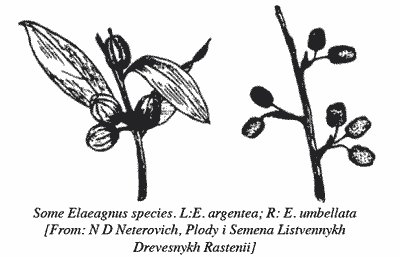
SOME HIMALAYAN WILD FRUITS WORTH TRIAL ELSEWHERE
There are thousands of wild-growing plants all over the world bearing edible fruits of acceptable quality. The fruits of some of such plants like the lingonberry of Sweden, the quandong of Australia, and daru (a wild pomegranate) of India, are even marketed on a big scale like commercial fruits. In the case of some plants like wild amla (Emblica officinalis Gaertn.) of India, the demand is always more than the supply.
A strong need is being felt by fruit growers throughout the world for diversification into new crops as the traditional fruit crops are under severe pressure due to increasing production and declining profits. Wild fruits can be an excellent source for the choice of species for trial as new commercial crops. Kiwifruit is a good example of promotion of a wild fruit as a new commercial fruit crop.
The mid-Himalayan region of Pakistan, India, Nepal, and Bhutan has many wild-growing plants bearing edible fruits. Parmar and Kaushal (1982) have studied the characteristics of 26 such plants and have proposed the organized cultivation of a few of these wild plants as orchard plants or multipurpose tree species.
The region varies in altitude from 800 to 1800m and has a subtemperate climate resembling that of most countries in Southern Europe. The region is cold for mandarins and warm for Delicious apples. The usual fruit crops of the area are peach, apricot, plum, almond, Japanese persimmon, walnut etc.
It is felt by the author, on the basis of his experience in some European countries, that the following Himalayan wild fruits may be able to grow there. These fruits should therefore be introduced for trial as new fruit crops.
Kaphal (Myrica nagi Thunb.): This is an evergreen tree growing in the forests. It is found throughout the mid-Himalayas at altitudes ranging between 1300 and 2100m. It bears small seedy fruits, deep red to purple at maturity, which are very tasty. The fruits sell in retail at a price almost twice that of mango or apple.
Kaphal is a medium to large tree attaining a height up to 15m. This plant grows wild in the forests and wastelands only, and so far no attempt has been made to domesticate it. The population of kaphal trees is declining every year due to deforestation and reclamation of wastelands. The fruits are picked by the villagers during the season and sold in the markets of the neighbouring hill towns.
Kaphal is a slow-growing tree and can only be propagated through seed. Attempts for its asexual propagation through cuttings, even under mist, have been futile.
Wild fig (Ficus palmata Forsk.): This is a very commonly occurring wild plant in the Himalayas up to an elevation of 1550m. Surprisingly, the trees of this wild plant are rarely seen in the forests. They mostly grow around the villages in the wastelands and in the cultivated fields.
Wild fig of the Himalayas has almost the same quality as the superior cultivated type of the Mediterranean region. The fruits are, however, smaller in size. As the cultivated fig (Ficus carica L.) cannot be grown in all places due to its very exacting climatic requirements, the Himalayan wild fig may prove to be a suitable alternative to this fruit.
The wild fig tree can grow and bear fruits even in colder places experiencing high rainfall at the time of fruit ripening. It is a deciduous tree having a height of 6-10m. The new growth and flowering start in March, and the fruits start ripening from the second fortnight of June and continue to do so till the middle of July. There is a great variation among wild plants regarding yield and fruit quality but still a plant produces 20-25 kg of fruit during one season.
Besides the fruit, the newly-emerging leaves and very young fruits are used as a vegetable in India. The fruits are about 2.5 cm in diameter and weigh about 6g each. Trees bearing even larger fruits are also met with. The fruits have an excellent taste.
The TSS (total soluble solids) content is 12.1 %. The ripe fruits are quite juicy. The juice can easily be extracted by hand pressing. One kg of fruit yields about 450 ml of juice. This wild fruit can be propagated both by seed and by cuttings.

Wild Himalayan Amla (Emblica officinalis Gaertn.): Amla is a fruit of Indian origin and grows mostly in tropical parts. It is cultivated for its fruits, which have a very high vitamin C content. This ranges between 1100 and 1700 mg per 100g. No other fruit except the Barbados cherry (Malpighia glabra L.) is known to have so much vitamin C.
The amla fruits are always in great demand. The wild amla is a form of the superior cultivated amla. It grows wild, mostly in the forests, in the mid-hill regions of the Himalayas which have a subtemperate climate. The cultivated amla cannot be grown in all places as it is highly susceptible to frost. The Himalayan wild amla, on the other hand, is a relatively cold-hardy plant.
Some of the places where it is seen growing even experience light snowfall. This wild fruit can therefore be used for extending the cultivation of the tropical amla even to subtemperate regions.
The Himalayan wild amla is a small to medium sized tree attaining a height up to 5.5m. This is a very ornamental plant, especially when the branches are laden with fruits. The fruits are 2 to 2.5 cm in diameter and weigh about 6g each. There is, however, considerable variation in the fruit size of different trees and it is possible to select clones with relatively larger fruits. The fruits of the cultivated amla are larger in size, but except for the size, there is no other difference between the fruits of the Himalayan wild amla and the cultivated amla of the Indian plains.
The wild Himalayan amla can be propagated by seed. Asexual propagation is carried out by inarching. As this wild fruit tree is very ornamental, it is also ideally suited for planting as an avenue tree.

Ghain (Elaeagnus umbellata Thunb.): This is a deciduous shrub growing wild in the forests at altitudes ranging between 1200 and 2100m. It attains a height up to 3.5m. The young shoots and branches of this wild plant are clothed with white scales, imparting a very attractive silvery appearance. These scales, however, disappear later with the commencement of the rains.
The ghain bears small pink fruits which are very good to eat. The fruits are offered for sale at many places. These measure 3-9 mm in length and about 5 mm in diameter. They start ripening from the middle of July and continue to do so till the middle of August. Each fruit weighs around 135 mg. The fruits of ghain are a fine blend of sweet and sour and have a very good taste. Their TSS content is 14.5%. They contain 8.3% sugars and 1.5% acid. This fruit is very rich in protein, containing 4.47% of it.
This plant can be multiplied by seed. The shrub of ghain is quite attractive. It is thorny too. It can therefore also be utilized for planting as a protective hedge around fields or gardens.
Daru (Punica sp.): This is a kind of pomegranate which grows wild in very large numbers in the forests and wastelands throughout the mid-Himalayan region. Sharma, after a detailed comparison of this wild plant with the cultivated pomegranate, is of the view that this wild fruit should be designated as a separate species of the genus Punica. As the acid content of the fleshy seeds of wild pomegranate is quite high (5.5%), these taste sour even though they also contain 10.1 % sugars. The juice also contains 36 mg of vitamin C per 100 ml.
The fruits of daru are not consumed fresh like the cultivated pomegranate due to the excessive acid content. The fleshy seeds are taken out and then dried in the sun. The finished product is called anardana (anar (Hindi)=pomegranate, dana=grain). It is used in a number of ways as a souring agent for various food preparations throughout India.
Every household buys a quantity of anardana during the season for meeting its annual requirements. It is reported to have a cooling effect on the body and a mixture of anardana, sugar and aniseed (Pimpinella anisium L.), ground together, is prescribed to those who lose appetite after long fevers or after taking a large dose of allopathic medicines, particularly the antibiotics.
The rind of daru yields a fast yellow dye, which is used for dyeing cloth and also for making hair dye. The rind is also used in the tanning of leather. The rind of this wild fruit is also a commercial commodity and traded like anardana.
Daru is a deciduous tree attaining a height up to 10m depending upon the soil. The new spring growth is pigmented, and the trees look quite ornamental due to this during the spring. The flowers start appearing after about four weeks and are also very attractive. The fruits of daru are about 80 grams each and are thus much smaller than the cultivated pomegranate. There, however, exists a large variation in fruit size and quality among the wild plants which offers scope for the selection of superior clones.
New plants of daru can be raised by seed as well as by cuttings. This is a very hardy plant and can grow even on very poor soils. Daru trees can also be planted on wastelands for afforestation. This plant can also act as a very good avenue tree because of the pigmented foliage in the early growing season and a long blooming season of attractive flowers.
In view of the utility and potential of these wild growing plants, a project is soon going to be taken up for the domestication of these fruits by our Department of Fruit Breeding and Genetic Resources.
Reference
Parmar, C. and M.K. Kaushal. (1982). Wild fruits of the sub-Himalayan region. Kalyani Publishers, Ludhiana. pp xii+ 136.
[Based on an article in Chronica Horticulturae, June 1991]
[Ed. note: see also http://www.fruitipedia.com/]
DATE: July 1992
* * * * * * * * * * * * *
